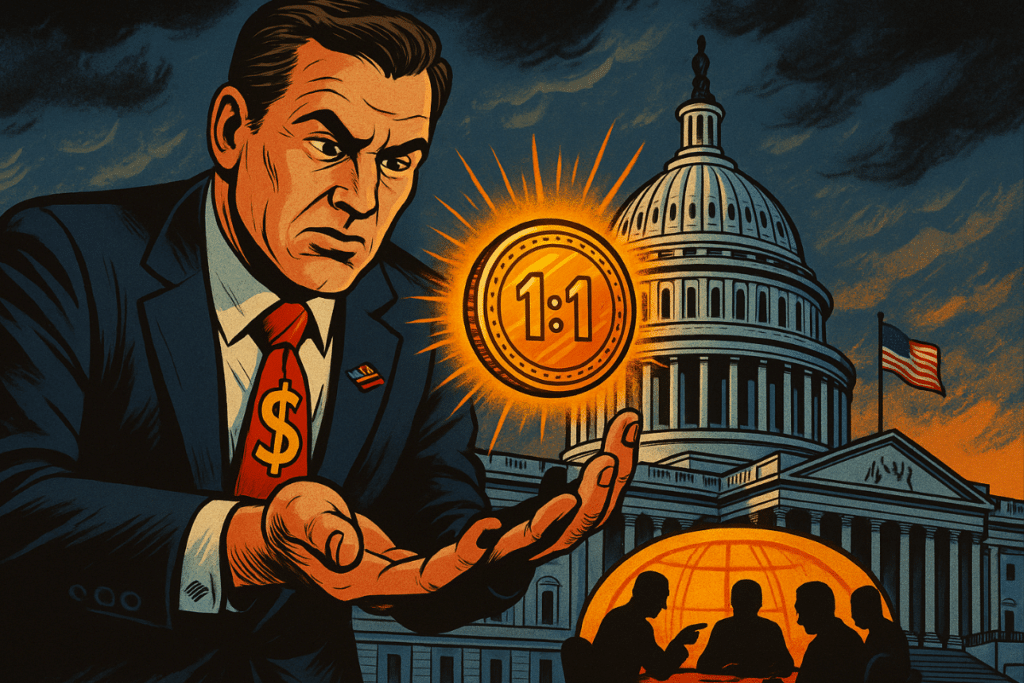Bank of America’s Stablecoin Play Hinges on U.S. Lawmakers’ Next Move
Stablecoins, which are digital currencies pegged to assets like the U.S. dollar, are getting a lot of attention these days. Investors, banks, and policymakers alike are keeping a close eye on them. Bank of America is no different—but they’re holding off on launching their own stablecoin until there are clear rules in place.

In Brief
- Bank of America won’t launch a stablecoin until clear regulations are in place.
- The U.S. Senate is advancing the GENIUS Act to regulate stablecoins.
- CEO Brian Moynihan warns banks to prepare for a deposit shift as stablecoins gain traction.
Moynihan: Bank of America Taking a Cautious Approach to Stablecoins
Brian Moynihan, Chief Executive Officer of Bank of America, has stated that the bank is not in a hurry to enter the market. Instead, it is waiting for comprehensive legislation and market infrastructure to be established. Only then, he noted, will the bank assess whether issuing a stablecoin makes strategic and commercial sense — a stance that aligns with how American banks are now cautiously approaching Bitcoin and digital assets.
If they get the Genius Act or the stable act or anything like that passed—and then they get the markets infrastructure enablement piece—that will allow us to figure out whether there’s really a business proposition in stablecoins.
Brian Moynihan
U.S. Senate Moves Forward With Stablecoins Legislation
In the United States, lawmakers are working on a bill to regulate stablecoins. The GENIUS Act bill would set strong rules on how stablecoins should be backed and handled. It mandates that each stablecoin must be supported by real U.S. dollars or other assets that can be quickly sold. Also, it requires yearly audits for large stablecoin issuers that handle over $50 billion.
On Wednesday, the US Senate made progress on the bill. Senators voted 68 to 30 to move it forward. This step allows more discussion and brings it closer to a final decision.
Senator Tim Scott, one of the main figures behind the bill, said this was a key step. He pointed out that both major parties worked together to make it happen. While some Democrats chose not to support the bill, others did, showing a mix of opinions.
Among those in support was Senator Ruben Gallego. Not all were on board, with names like Chuck Schumer and Elizabeth Warren voting against it. Still, the overall direction is clear. There is growing agreement that the market needs proper rules to manage the rise of stablecoins.
Strong Support from the White House
The U.S. administration has expressed support for the bill. President Donald Trump’s advisors confirmed he is in favour of the legislation and wants it passed before Congress adjourns for the August recess. Vice President JD Vance also stated that Trump plans to sign the bill once it reaches his desk.
Speaking at the Bitcoin 2025 conference, Vance said stablecoins should be viewed as a benefit, not a threat. The strong backing from the White House is giving banks and companies greater confidence that clear regulation is on the way.
With a law in place, financial institutions may feel more secure in moving ahead with their own stablecoin initiatives.
Market Response and Institutional Strategy
While regulation continues to develop, private sector interest in stablecoins is already strong. Last week, Circle, a major stablecoin issuer, went public on the New York Stock Exchange with a strong market debut. Its shares more than doubled on opening day, reflecting robust investor confidence and renewed optimism in the digital asset market.
At the same time, several major U.S. banks — including JPMorgan Chase, Citigroup, Wells Fargo, PNC, and Bank of America — have reportedly formed a working group to explore the possibility of launching a joint stablecoin initiative.
Among the ideas being discussed is the creation of stablecoin payment network similar to Zelle. Such a system would enable banks to offer fast, secure transactions using digital currencies under their control.
A clear legal framework would give major banks the certainty they need to explore stablecoin solutions safely, within a regulated environment. It would also allow institutions to:
- Launch innovative stablecoin-based financial products.
- Attract more customers with faster, cheaper payments.
- Integrate stablecoins into everyday transactions.
Moynihan acknowledged uncertainty about how large the stablecoin market will become but stressed the importance of being ready. He explained that if people start using stablecoins like regular transactional accounts, banks must ensure those deposits stay within their systems. Otherwise, there could be a significant shift of funds away from traditional banks.
Maximize your Cointribune experience with our "Read to Earn" program! For every article you read, earn points and access exclusive rewards. Sign up now and start earning benefits.

Ifeoluwa specializes in Web3 writing and marketing, with over 5 years of experience creating insightful and strategic content. Beyond this, he trades crypto and is skilled at conducting technical, fundamental, and on-chain analyses.
The views, thoughts, and opinions expressed in this article belong solely to the author, and should not be taken as investment advice. Do your own research before taking any investment decisions.